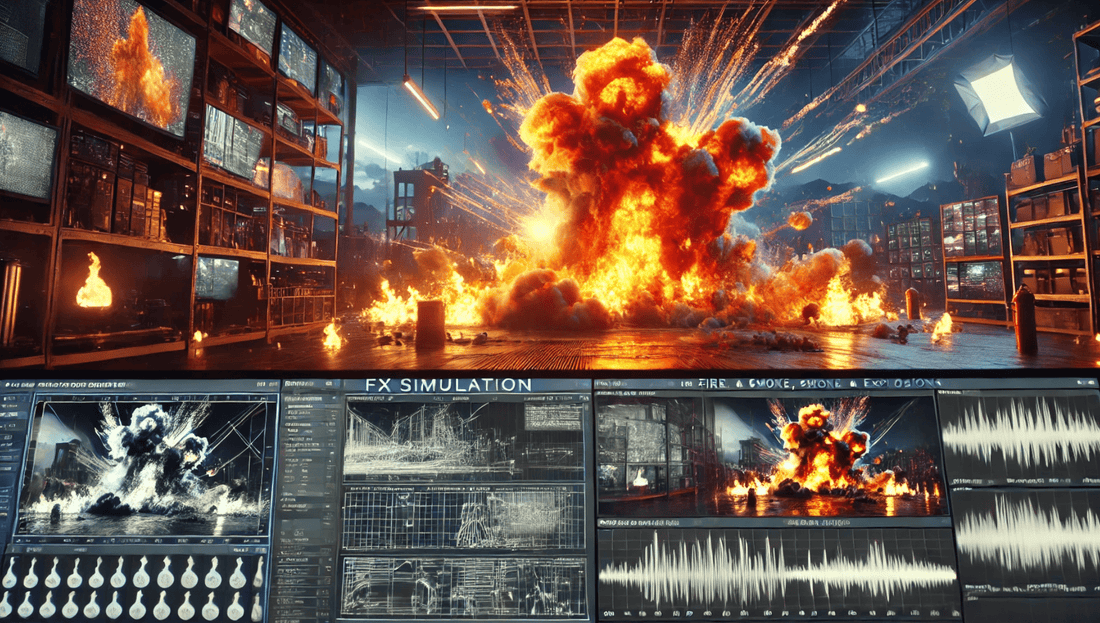
FX Simulation in VFX: Fire, Water, Smoke, and Explosions
Share
FX Simulation in VFX: Fire, Water, Smoke, and Explosions
Introduction
FX simulation is one of the most complex and visually stunning aspects of VFX production, used to create fire, water, smoke, explosions, and destruction. From massive battle sequences in Game of Thrones to hyper-realistic water simulations in Avatar: The Way of Water, FX simulation plays a key role in making digital worlds feel believable.
Creating realistic natural phenomena requires advanced physics-based simulations, procedural techniques, and specialized software like Houdini, Phoenix FD, and Bifrost. In this article, we’ll explore how FX simulation works, the tools used by industry professionals, and the best techniques for achieving photorealistic results.
What Is FX Simulation in VFX?
FX (Effects) simulation is the process of mimicking real-world physics and natural phenomena in CGI. Unlike traditional animation, FX simulations rely on dynamic particle systems, fluid solvers, and procedural generation to replicate realistic behavior.
Types of FX Simulations in VFX:
🔥 Fire Simulation – Realistic flames, explosions, and embers.
🌊 Water Simulation – Oceans, rivers, rain, splashes, and floods.
🌫 Smoke and Fog – Atmospheric effects, clouds, and dust.
💥 Explosions and Destruction – Debris, shockwaves, and destruction physics.
🔹 Example:
In Avengers: Infinity War, Houdini was used to simulate the disintegration of half the universe after Thanos’ snap.
How FX Simulations Work - Step by Step
1. Creating a Particle System
FX simulations often start with particles, which act as small data points that can represent smoke, fire, or liquid.
✅ Emitters create particles (e.g., smoke from a fire).
✅ Forces like wind, gravity, and turbulence control particle motion.
✅ Colliders ensure particles interact with objects realistically.
🔹 Example:
In Interstellar, particle-based simulations created the giant dust storms on alien planets.
2. Fire and Explosion Simulations
🔥 Fire simulation involves temperature fields, fuel sources, and turbulence to mimic real flames.
Techniques for Realistic Fire FX:
✅ Voxel-based simulation (Pyro FX in Houdini) – Creates volumetric fire and smoke.
✅ Turbulence modeling – Adds chaotic motion to flames.
✅ Heat distortion – Simulates air displacement caused by fire.
🔹 Example:
In The Dark Knight, explosions were enhanced with CGI fire and shockwaves for added impact.
3. Water and Fluid Simulations
🌊 Water simulation requires advanced fluid solvers to mimic waves, splashes, and dynamic water movement.
Key Fluid Simulation Methods:
✅ SPH (Smoothed Particle Hydrodynamics) – Used for splashes and droplets.
✅ Flip Solver (Fluid-Implicit Particle) – Combines particle and grid methods for realism.
✅ Navier-Stokes Equations – Simulates fluid motion based on physics principles.
🔹 Example:
In Pirates of the Caribbean: Dead Man’s Chest, water simulations helped create the Kraken’s giant waves and whirlpools.
4. Smoke, Fog, and Atmospheric Effects
🌫 Smoke and fog simulations are used for explosions, magical effects, and atmospheric realism.
Techniques for Realistic Smoke and Fog:
✅ Voxel-based volumetrics – Used in Houdini Pyro FX and Phoenix FD.
✅ Dissipation and turbulence control – Ensures smooth motion.
✅ Ray-marched rendering – Improves visual depth and realism.
🔹 Example:
In Harry Potter, volumetric smoke simulations created magical spells, apparitions, and the Dementors’ fog.
5. Destruction and Rigid Body Simulations
💥 Destruction FX involve fracturing objects, simulating debris, and adding shockwaves for realistic explosions.
Key Techniques for Destruction FX:
✅ Fracturing (Voronoi Fracture, Boolean Fracture) – Breaks objects into realistic chunks.
✅ Rigid Body Dynamics (RBD) – Simulates how objects collide and break apart.
✅ Debris and Dust Layers – Adds realism to explosions.
🔹 Example:
In Man of Steel, Houdini’s Rigid Body Simulation was used to destroy entire skyscrapers realistically.

Best Software for FX Simulation in VFX
| Software | Purpose |
|---|---|
| SideFX Houdini | Industry-standard procedural FX simulation. |
| Autodesk Bifrost | Node-based fluid and smoke simulation for Maya. |
| Phoenix FD | Fire, smoke, and liquid simulation for 3ds Max & Maya. |
| EmberGen | Real-time smoke and explosion generation. |
| RealFlow | High-end water and fluid simulation. |
🔹 Example:
For The Lion King (2019), Houdini was used to simulate dust, wind, and fire effects in the African savanna.
Challenges in FX Simulation
1. High Computational Costs
⚡ Problem: Realistic FX require huge computing power, leading to long simulation times.
💡 Solution: Use adaptive resolution and GPU acceleration to speed up calculations.
2. Realism vs. Artistic Style
🎨 Problem: Too much realism can feel boring, while stylized FX can break immersion.
💡 Solution: Balance physical accuracy with artistic direction.
3. Data Management
🖥 Problem: Simulations generate massive cache files, making storage a challenge.
💡 Solution: Use data compression techniques and efficient caching.
🔹 Example:
For Frozen II, Disney used procedural ice growth simulations that required terabytes of cache data.
Future of FX Simulation in VFX
With advancements in real-time simulation, AI-driven physics, and procedural techniques, FX simulations are becoming more efficient and photorealistic.
🔹 Real-Time FX with Unreal Engine – Used for instant fire and smoke previews.
🔹 AI-Powered Simulations – Machine learning predicts fluid and explosion behaviors.
🔹 Cloud-Based Simulation – Studios use cloud computing for large-scale destruction scenes.
🔹 Example:
The Mandalorian used real-time smoke and dust FX in Unreal Engine, reducing post-production time.
Conclusion
FX simulation is a key element in VFX, bringing fire, water, smoke, explosions, and destruction to life in film and TV. By using advanced particle systems, volumetrics, and fluid solvers, VFX artists can create hyper-realistic natural phenomena.
With the rise of AI-powered simulation, real-time rendering, and cloud-based workflows, FX simulation is becoming faster, more dynamic, and more immersive than ever.
🚀 Want to learn more about VFX workflows? Stay tuned for expert insights and best practices!
References
- The VES Handbook of Visual Effects – Jeffrey A. Okun & Susan Zwerman.
- SideFX Houdini Documentation (2024) – Advanced Pyro & Fluid FX.
- Pixar's RenderMan Blog – Realistic Smoke and Fire in CGI.
- SIGGRAPH 2023 – Future of Real-Time FX Simulation.
- Autodesk Bifrost Guide – Procedural Fire and Liquid Effects.
